New Imagine Math Live Teaching Summer Hours
May 2025
Access live support all summer long
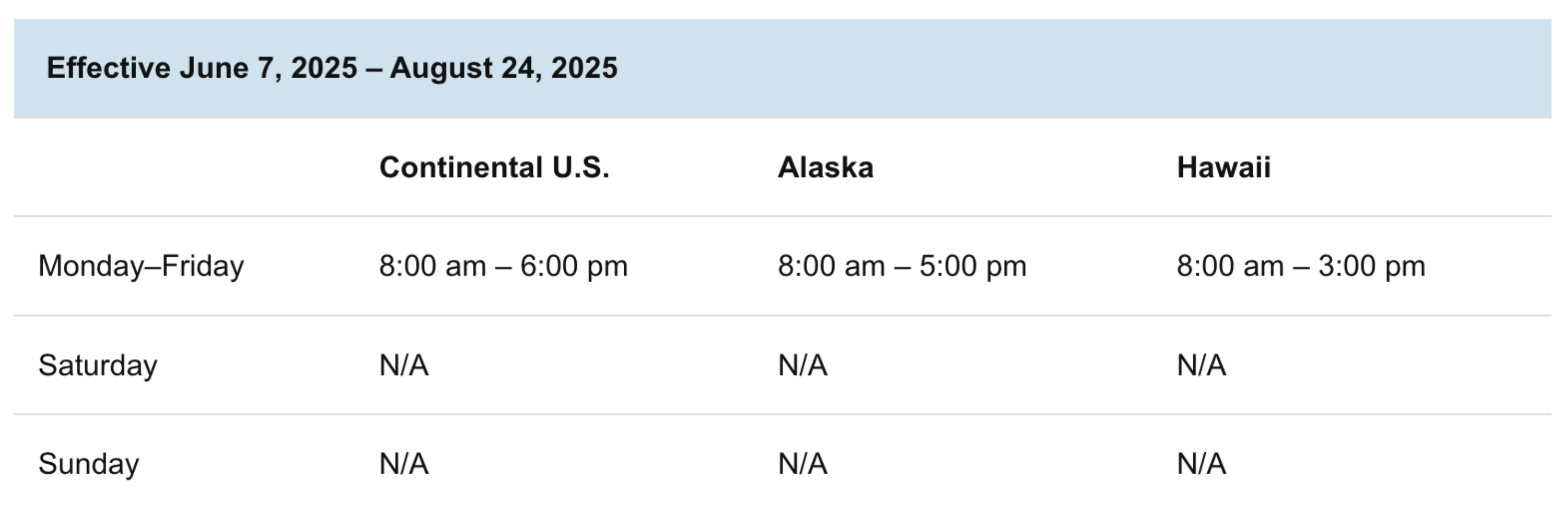
May 2025

September 2024
Did you know? Following each Imagine Math benchmark test, students are classified into Performance Levels. Combined with the Quantile® Measure, these levels can be used to group students into similar skill levels and determine appropriate instruction.
The following states have aligned their state-wide assessments with the Quantile® Framework.
Through Imagine Math’s partnership with MetaMetrics®, educators in these states will see Benchmark Performance Levels reflect those used in their state end-of-course assessments. Educators in the states listed above should refer to the Imagine Math “Performance Level Guide”, accessible in the Teacher Dashboard > Reports > Benchmark. Note that definitions of Performance Levels — and the Quantile® Measure ranges that comprise them — vary by state.
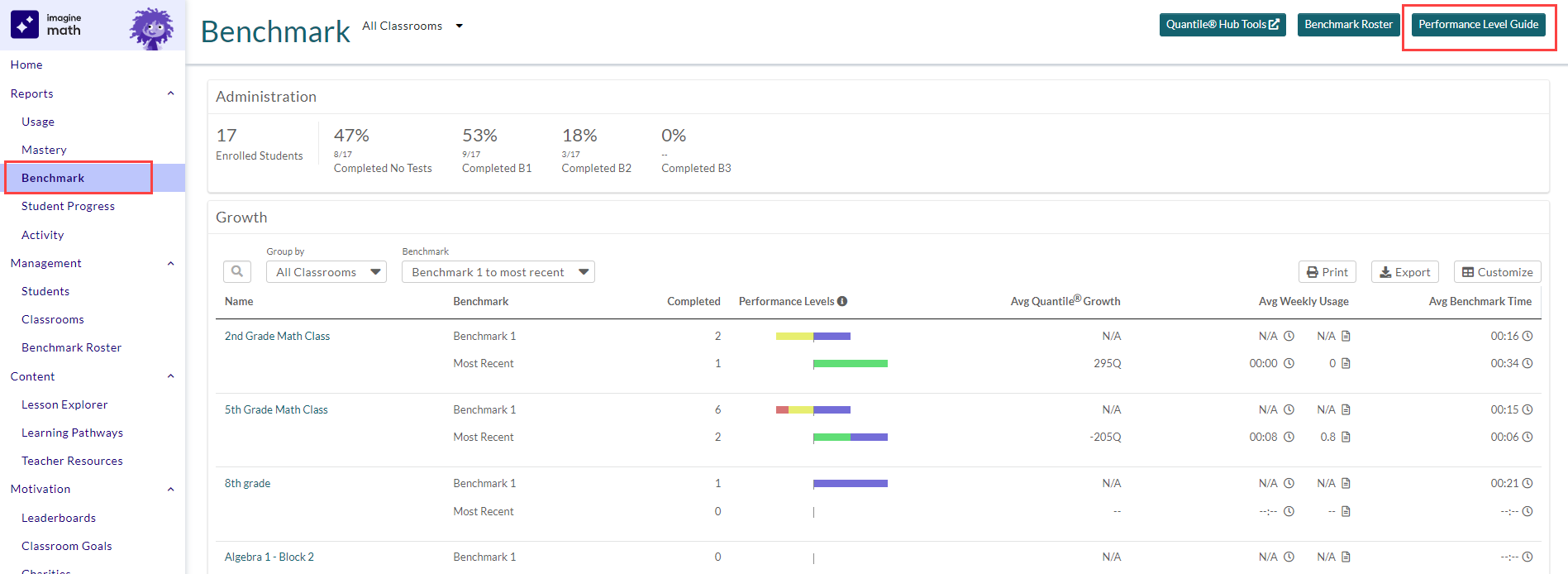
May 2024
The Imagine Math and Imagine Math Facts teams have improved the reset process for Back-to-School 2024:
For more details, visit this Help Center article.
May 2024
Based on educator feedback, Imagine Math has added printable vocabulary word lists. With these printable lists for grades 3+, students will be able to practice key math vocabulary terms using the word, its definition, and an explanatory image. Educators can find the printable word lists for grades 3–5, 6–8, and 9–12 in Teacher Resources under “Vocabulary Lists.”
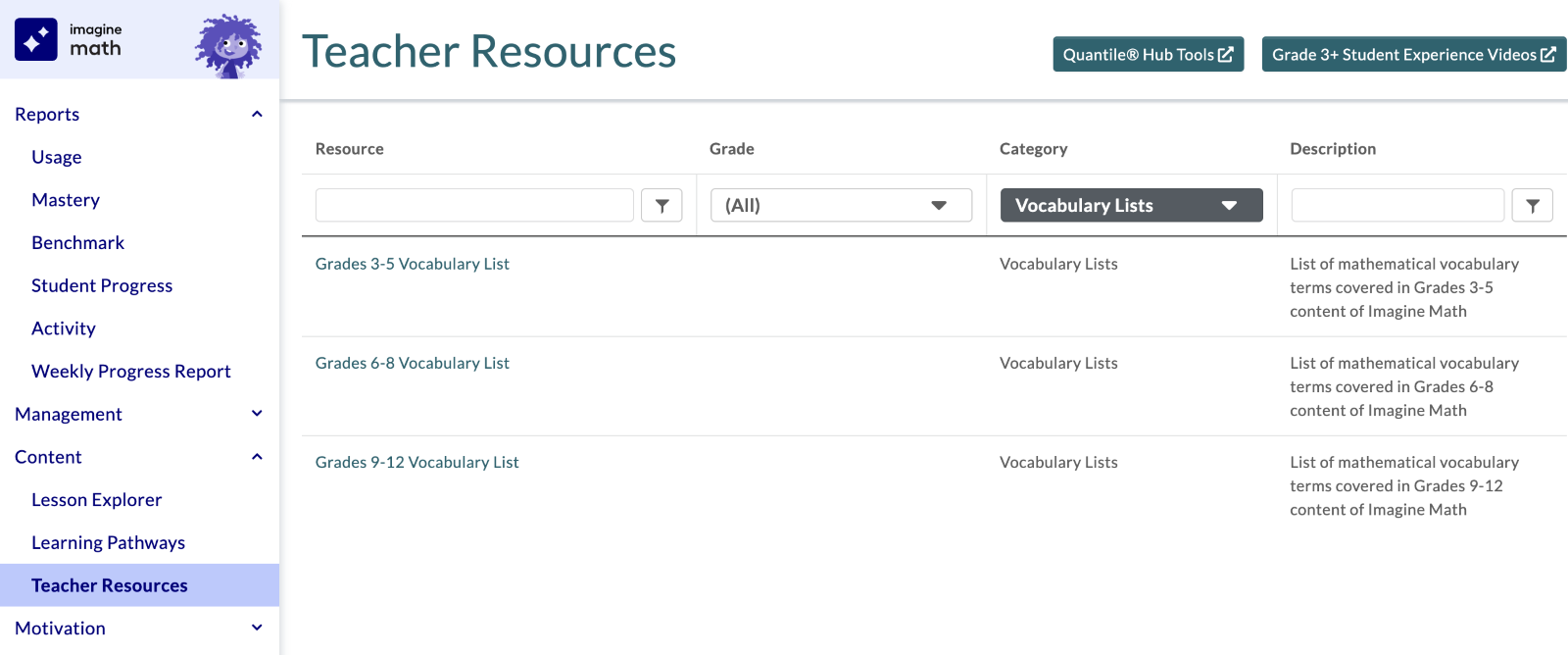
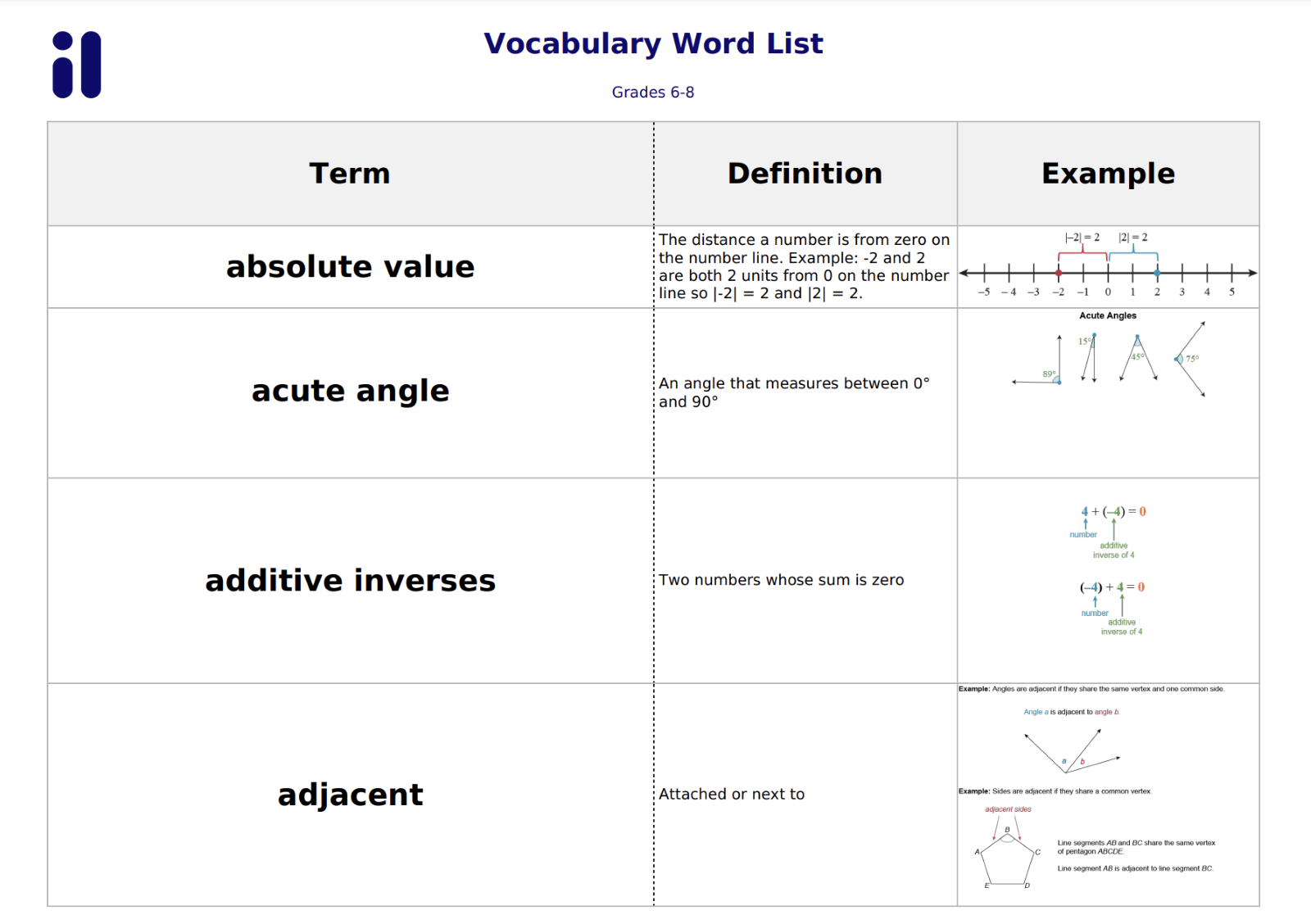
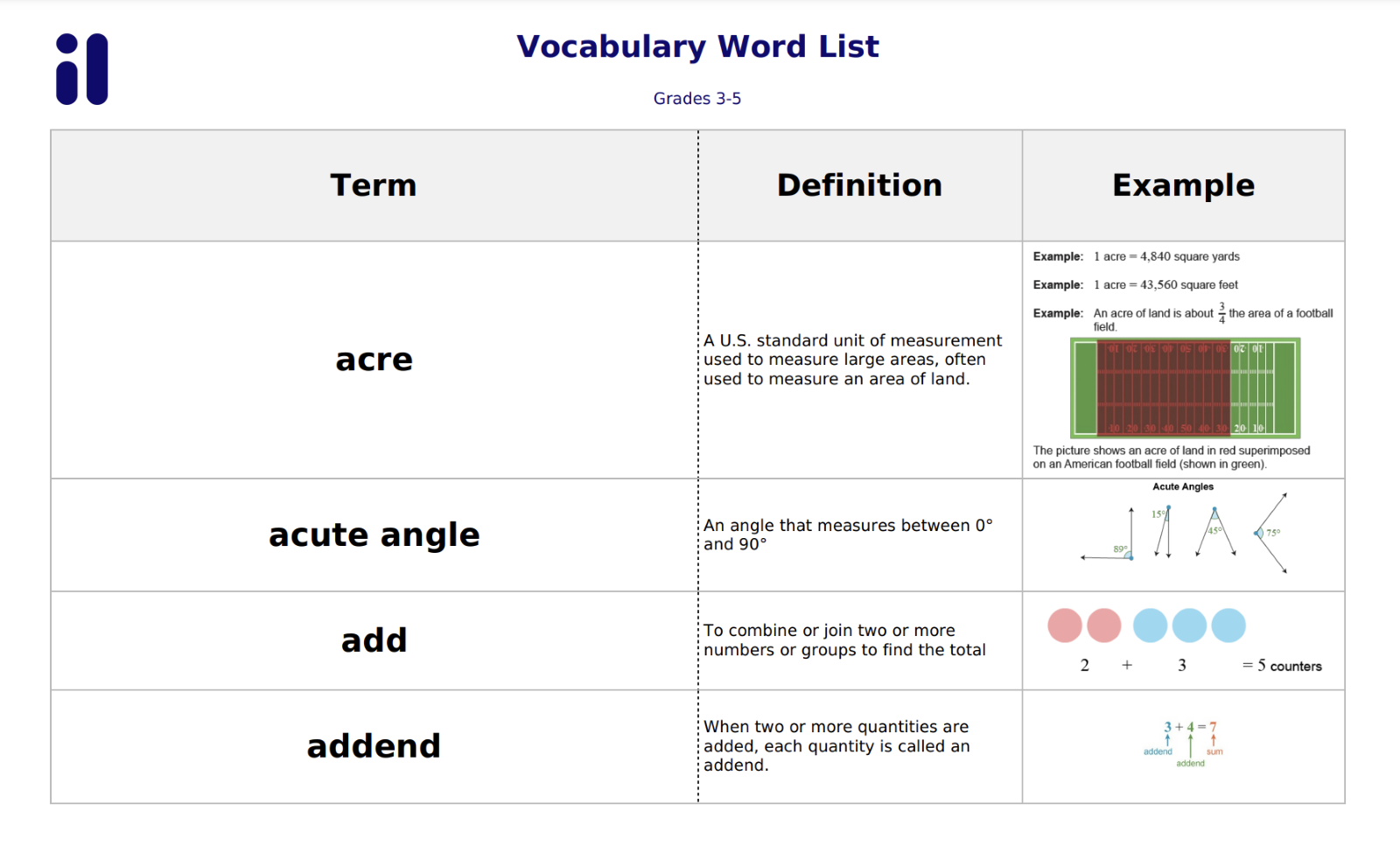
April, 2024
For security reasons, passwords are no longer displayed in the Imagine Math educator portal. Educators can still change a student’s password to a new password, but they can’t view the student’s current password. Note that we’ve kept the word “password” on student start cards with a blank space underneath for educators to write it in.
Due to this important security enhancement, 22 Help Center articles, including Printing student start cards and Finding your student’s Math Suite username and password, were updated to replace screenshots showing passwords on the start cards and in various pages of the Imagine Math program.
We’ve added a suite of English and Spanish printable resources in Imagine Math Teacher Resources under the “Live Teaching” category filter to support student success in working with Imagine Math Live Teachers. Learn more about Imagine Math Live Teachers in the Imagine Math Help Center, including student-facing how-to videos and more!
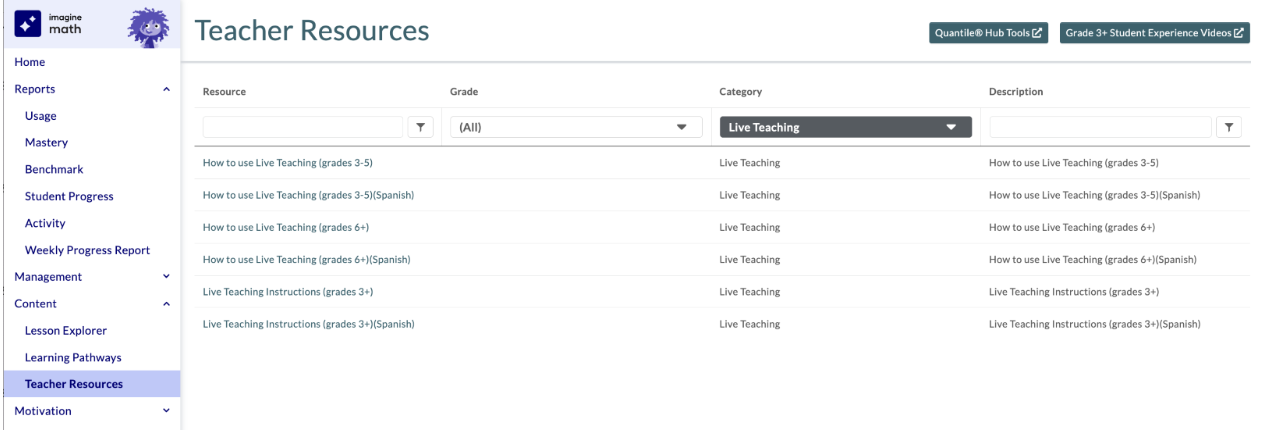
Live Teaching will have updated operating hours for the 2024-25 school year.*
Imagine Math Live Teaching Hours 2024-25 (All times local)
Monday–Friday: 8:00am–10:00pm
Saturday: 9:00am–4:00pm
Sunday: 6:00pm–10:00pm
*Live Teaching hours for the current 2023-24 school year can be found in the Imagine Math Help Center.
April, 2024
We’ve added a suite of English and Spanish printable resources in Imagine Math Teacher Resources under the “Live Teaching” category filter to support student success in working with Imagine Math Live Teachers. Learn more about Imagine Math Live Teachers in the Imagine Math Help Center, including student-facing how-to videos and more!

Live Teaching will have updated operating hours for the 2024-25 school year.*
Imagine Math Live Teaching Hours 2024-25 (All times local)
Monday–Friday: 8:00am–10:00pm
Saturday: 9:00am–4:00pm
Sunday: 6:00pm–10:00pm
*Live Teaching hours for the current 2023-24 school year can be found in the Imagine Math Help Center.
March 2024
As of March 5, student passwords no longer appear anywhere in the Imagine Math or Imagine Math Facts solutions to align with best-practice security measures around protecting student data. Educators continue to be able to update student passwords from the student’s account page.
Learn more about this important security update in the Imagine Math Help Center.
February 2024
The table of contents documents make offline practice even easier to access with links to every “Printable” resource.
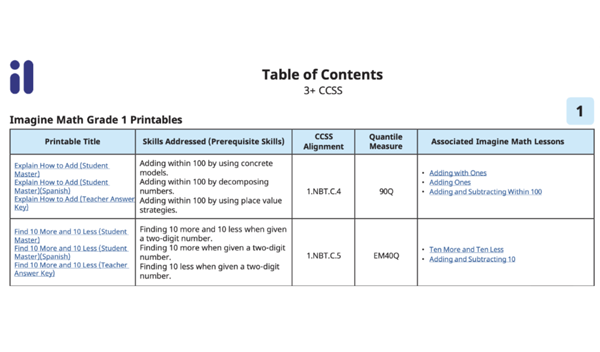
June 9, 2022 8:00 am
Imagine Math’s THINK points program allows students to earn rewards for themselves, their class, and charities by completing lessons.
What motivates you to work harder? I knew I was getting closer to middle age when I realized the harder I worked, the better I’d sleep — motivation level 10: unlocked. Sometimes motivation comes in the form of little bonuses (ahem, dessert), sometimes it’s a healthy sense of competition, and sometimes the prospect of a warm, fuzzy, ‘do-gooder’ feeling is what gets us to tackle a challenge.
It turns out that kids and adults aren’t that far apart in this respect; Imagine Math has demonstrated as much with its THINK points program. This innovative motivation system inspires students to learn by helping develop problem-solving skills, perseverance, and confidence. As students work through their Imagine Math lessons, they earn THINK points. THINK points are awarded for completing lessons, with additional points awarded for performing well. Students can use their points to design and accessorize their Imagine Math avatar, contribute to classroom goals (pizza party, anyone?), or donate money to students in need.
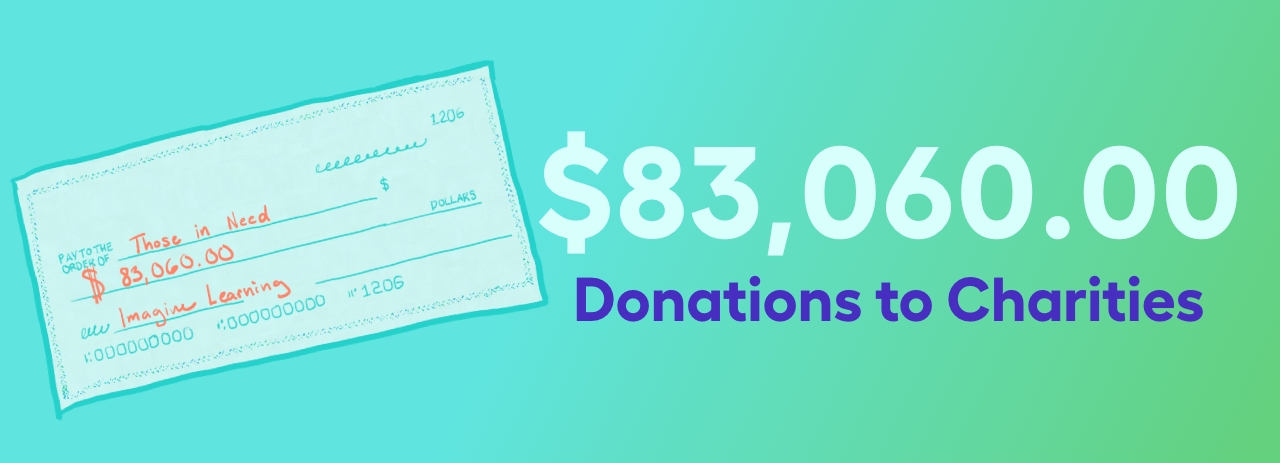
The points students earn by working through lessons are applied to their total number of points after they have completed the entire lesson, which helps keep them motivated to finish the full lesson before spending their points.
They can view their points on their home screen and the Class Leaders dashboard. Students can see the number of THINK points they’ve earned in the current lesson, the total of the points they’ve earned this year, and the number of points available to spend at the moment (grand total minus points already spent).
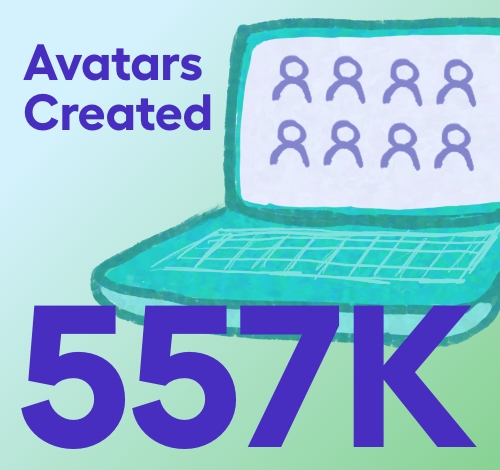
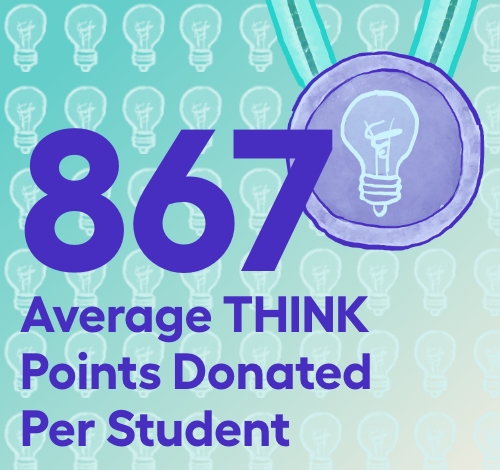
The points leaderboard shows a hierarchy of who has earned the most THINK points that week and who has completed the most lessons. It updates every 15 to 30 minutes and resets every Saturday evening, only displaying the number of points each student has earned for the current week. It’s designed to continually motivate students and give each student a fair chance to be at the top for that hour, day, or week.
As a reward and part of what makes Imagine Math so engaging, students get to choose how they’ll spend their hard-earned THINK points. Some like to build out their avatars, expressing themselves with different skins, features, and accessories. Others are motivated to contribute to the teacher-established classroom goal, and an inspiring number of students opt to transfer their points into monetary gifts to charity. The charity calendar changes month to month, exposing students to a variety of opportunities to make a difference in their world.
“I wanted to be the No. 1 on the leaderboard in the state of Texas, so I had to do a lot of lessons – and that’s how I racked up the points. It makes me very proud that I can be of some help to the people in need.”

Imagine Learning is proud to report that 2021–2022’s students donated to 29 beneficiary charities, choosing to transform their math achievements into an impressive $83,060 for worthy causes! (Cue Whitney Houston because we, too, believe ‘the children are the future.’) It’s an incredible testament to their characters and their efforts to advance their learning, and as a bonus, it gives teachers a morale boost.
Tracy Gonzalez, a 4th-grade math teacher at W.C. Andrews Elementary in the Gregory-Portland ISD, says, “it makes me so happy, and I’m so proud of my students when they enjoy donating their THINK points to charities! They are helping towards a great cause every time they do so!”
The American Red Cross Tornado Relief Fund was one of the partner charities this year. Vista Hills Elementary student Yash Anand was the top donor in the nation, earning a remarkable 1.6 million THINK points to contribute to the fund.
“I wanted to be the No. 1 on the leaderboard in the state of Texas, so I had to do a lot of lessons – and that’s how I racked up the points,” said Anand. “It makes me very proud that I can be of some help to the people in need.”
Students should be celebrated for working hard, whether they’re in it for the avatar, the parties, the competition, or the good karma. Their motivation can be as personal as the learning path they’re on, just as long as they also have a meaningful exploration of (and growth in!) mathematical understanding.
Kallie Markle lives in Northern California with her family of humans, house plants, and dogs. The humans take up the least amount of space. Before joining the education world, she wrote her way through national parks, concerts, tourism, and brewing.
March 15, 2022 8:00 am
When the goal is to encourage more girls to pursue an interest in science, technology, math, and engineering, words and representation matter.
If asked to name a famous female scientist, who comes to mind? For many of us, it is likely Marie Curie, who is the most well-known for a reason. She developed the theory of radioactivity and was the first female scientist to win a Nobel Prize, among other achievements.
Thanks in part to the critically acclaimed movie, Hidden Figures, you also may have thought of Katherine Johnson, the Black mathematician whose work helped the first manned spaceflight land on the moon.
Both Curie and Johnson paved the way for future women in STEM fields.
While we should absolutely celebrate these remarkable women, we also need to reflect not just on why most of us are able to name only one or two, but also on the impact of the lack of female scientist household names.
On a basic level, we can assume there are fewer women in STEM careers because, as a group, they do not see themselves represented in those fields. This becomes a feedback loop — girls grow up not seeing women in STEM, they don’t pursue STEM careers, and the cycle continues.

Catherine Cahn, founder of Twig Science and President of Core Curriculum at Imagine Learning, recently remarked on the power of language to both empower and exclude women and gender-diverse individuals. If a company is looking to hire a new CFO and they say in a meeting, “Where are we going to find him?”, that one tiny pronoun tells everyone exactly who they picture (and don’t picture) in the position.
It is like when you mention your new (female) doctor by title and are asked, “did you like him?”
These words contribute to the “persistent, subconscious images of male mathematicians and scientists that start at the earliest ages, [which] may be one explanation why girls enter STEM fields… at dramatically lower rates than boys.”
Teachers are in a unique position to disrupt this subconscious bias by being deliberate about language choices in the classroom. In order to make sure girls feel welcome in the sciences, we should also reflect upon how we represent scientists and mathematicians.
Here are three ways we can better represent girls and women in STEM:
Share biographical information about women in the sciences in your classroom, on social media, and with the kids in your life. Tell them about Curie and Johnson, of course! But also tell them about Jane C. Wright, who contributed to chemotherapy developments; Tu YouYou, who saved millions of lives with her malaria treatment; Françoise Barré-Sinoussi, who discovered HIV; Lydia Villa-Komaroff, who helped find a key molecule in Alzheimer’s diagnosis and treatment; Mae C. Jemison, the first Black American woman to travel to space; and many more.
They may not be as well-known as Marie Curie and Katherine Johnson, but the women in your community working in STEM fields are just as extraordinary – and possibly even more inspiring. We know that “girls who see women working in STEM careers are more likely to consider a career in science, technology, engineering or math.” Whether you have a friend working as a computer scientist, a cousin studying biology, or you make a connection at a local Society of Women Engineers event, being able to talk to a “real” woman in a STEM field could influence a young girl’s future choices.
If we want girls to picture themselves in STEM careers, we should start with the curriculum. That’s why Imagine Math PreK–2’s cast of characters is designed so that every student can see themselves reflected in the program. These characters narrate and demonstrate concepts to students in an engaging virtual environment created to look like the diverse world in which we live.
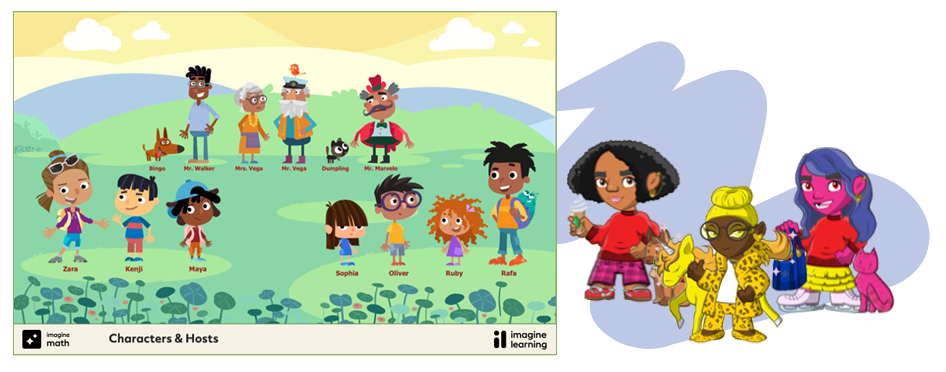
Ruby likes to play dress-up and wants to be an engineer when she grows up. As the main character in the Imagine Learning cast, she was intentionally designed to change the narrative about who excels in STEM careers.
Older Imagine Math students can design and customize their own avatars, so they can quite literally see themselves in their math program.
The more we normalize the image of females in STEM careers, the more young girls will picture themselves following in their footsteps. And just think, in a few years, we can add this generation’s names to a much longer list of famous female scientist household names.
Ally Jones is a California credentialed educator who specialized in teaching English language learners at the secondary level. Outside of education, she is passionate about fitness, literature, and taking care of the planet for her son’s generation.